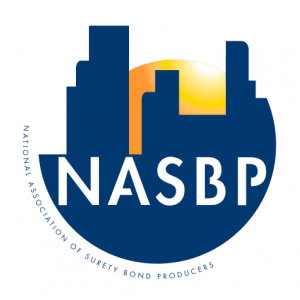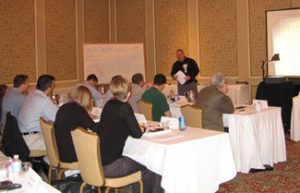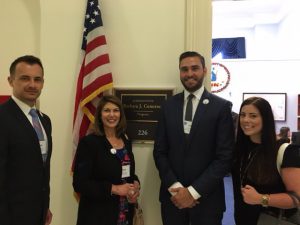NASBP’s Legislative Efforts ‘Bond’ Education With Action to Influence Policy

This month, we talked with Mark McCallum, Chief Executive Officer of the National Association of Surety Bond Producers, the association of and resource for firms employing surety bond producers and allied professionals. (If you’re like most people and are unfamiliar with the purpose and function of surety bonds, check out NASBP’s short primer.) NASBP member firms assist businesses of all sizes to qualify for surety bonds that guarantee the performance of construction and other contracts in the United States, Puerto Rico, Guam and elsewhere.
Founded in 1942, NASBP educates about the importance of surety bonds for a stable and growing American economy, advances the role of surety professionals, and advocates for increased access to and preservation of surety bonding practices.
McCallum has led NASBP since 2009. His experience in construction-related organizations, such as the American Institute of Architects and the Associated General Contractors of America, has given him a thorough understanding of the supports needed to sustain and grow a healthy surety bond industry while his legal training and experience continue to make NASBP’s advocacy strategy one that many associations can learn from.
Association Adviser: Tell us about your role with NASBP.

Mark McCallum: As the CEO of NASBP, I wear a variety of hats. One of them is in advocacy. I support our government relations team, Larry LeClair, our director of government relations, and Shannon Crawford, our assistant director of government relations, and the direction established by our Government Relations Committee. NASBP works to positively influence federal legislation and regulations as well as state and local legislation and regulations relating to the surety bond industry. I relish the opportunity to assist these dedicated professionals and volunteers in advancing our government relations agenda. I am also a registered federal lobbyist and regularly go up on Capitol Hill to talk to members of the US House of Representatives and US Senate on matters important to our association and our industry.
AA: Why did you register to become a lobbyist?
MM: The more I became involved in advocacy for surety bond producers, the more it made sense for me to register as a federal lobbyist. Being a registered lobbyist gives you greater clarity in terms of the responsibilities you have for compliance – what you need to do, what you must report, and what you are required to do in any given professional advocacy situation. We file regular activity and contribution reports and ensure that we are circumspect with everything we do on behalf of NASBP and our members to advocate for the strengthening of our industry.
AA: What are the NASBP’s advocacy goals?
MM: Surety bonding is an industry that was legislated into existence and could be legislated out of existence, so we remain active on the federal legislative front. Every year our director of government relations and members of the government relations committee articulate a federal legislative and regulatory agenda for our association. The agenda is recommended to our board of directors, who approve it at a board meeting. That’s our action document for the coming year‒ it states the broad goals and specific actions we will undertake at the federal level that contribute to our advocacy aims.
Current issues we’re working on include exempting the Miller Act bond threshold from periodic indexing for inflation; the Miller Act is a federal statute that requires prime contractors on federal construction projects to post bonds that guarantee the completion of their contractual duties and payment to their subcontractors. In existence since 1935, the Miller Act became indexed for inflation in 2006. We have always contended that it is not the type of statute that should be indexed. The Miller Act was enacted as protection for subcontractors and for suppliers performing on federal contracts by making sure they had a payment bond remedy in case the prime contractor failed to pay them. By the threshold being indexed, more federal contracts may be undertaken without payment bonds protecting downstream subcontractors.
So we are working with Congress to raise awareness of the importance of that measure and working with the House Small Business Committee to remove the indexing requirement in the Miller Act. A successful passage will ensure that smaller firms that work on federal construction projects and related efforts have access to adequate protections through surety bonds. There have also been a number of projects where individuals were permitted to provide surety bonds for a project without real assets behind the bond. This puts smaller businesses at risk as well, so as an industry we thought it important to reform the asset rules governing the placement of individual surety bonds on federal construction projects. These assets should be real, stable and safe and be in the custody of the federal government until contract performance is completed.
We introduced legislation to this effect and made sure it was included in the National Defense Authorization Act for Fiscal Year 2016. Few pieces of federal legislation move far enough in a single congressional period to become law. Congress has a very low rate of passage for standalone pieces of legislation. As a result, many interest groups try to insert their desired legislative language into the National Defense Authorization Act (NDAA) each fiscal year because it is federal legislation that determines the Department of Defense’s budget. It is almost always passed each year. So if you can make the case that your individual legislation is important to the defense structure of the country, you can be successful in getting it included in the NDAA and getting your legislation passed. We successfully used this vehicle in Fiscal Year 2016 to reform the asset rules governing individual surety bonds for federal projects. The NDAA was one of the few pieces of legislation that passed and became law that fiscal year. We’re currently waiting on implementation regulations to come out this fall.
AA: Does it typically take that long between the passage of legislation and introduction of related regulations?
MM: It usually takes longer. Sometimes, it can take three years between legislation enactment and final regulations to be in place. If we get to see regulations within a year, we are happy.
During this year, we aim to educate Congress about the importance of bond protections for alternative project delivery and for alternative infrastructure financing. Everyone’s heard of the importance of investing in infrastructure because such investment has lagged over the last several decades. To those investments, Congress is looking at alternative means of financing. Typically in the past, infrastructure has been funded by direct federal expenditures. Now, Congress is looking to private financing to fund, at least in part, large infrastructure projects. It’s not clear if the Miller Act would apply in the context of public-private partnerships. We believe the use of surety bonds should be a requirement of any infrastructure project that involves some level of federal funding to protect taxpayer dollars and the downstream parties that need reassurance of payment.
AA: What role does advocacy play in providing value for members of NASBP?
MM: I think of advocacy as another form of education. A lot of what we do is inform decision makers, whether they’re legislators or regulators, about the important purposes of surety bonds. For example, we teach that their basic function is as a critical prequalification device for the public, to reassure those involved in public contracting that:
1. Qualified bidders are participating in the construction bidding process.
2. Completion of the contract and payment to subcontractors involved is guaranteed.
Not every contractor will receive surety credit – it’s underwritten on the basis that credit is extended to those who have the character, capital, and capacity to complete the contract, so that when the government awards a contract to a firm, the government is awarding it to a qualified business that can perform the contract successfully. When a bonded business defaults, the surety steps in to fulfill the contract obligations.
It is important to know that surety is regulated as insurance but doesn’t act like traditional insurance. Surety bonds are underwritten under the assumption that those earning surety credit are capable of successfully performing, and the surety will not suffer a loss. As a result, the surety that gives credit will expect to be indemnified for any amounts it pays out on behalf of the party receiving the surety credit. This works differently than property or casualty insurance, which presumes a loss. This key difference makes surety more like a credit arrangement, such as a bank loan.
AA: What advocacy resources do you and your fellow staff create and curate for your membership?

MM: Many individuals are not familiar with surety bonding, so we have created a variety of materials that explain bonding. Whether you’re a small contractor, a subcontractor, a designer, or an owner, we have materials that explain why bonding is important from your perspective and how firms can verify valid bonds and protect themselves. We write brochures, pamphlets and white papers, and even offer an online course for small contractors. Some of these materials are available at SuretyLearn.org.
We also have extensive professional development resources for bond producers and surety underwriters. We offer in-person and online training. Surety professionals can go to our Surety School website to find out about career-enhancing training for surety professionals.
AA: One of your annual advocacy-related events is your Legislative Fly-In. What are the origins of this event?
MM: We’ve done a Fly-In for a number of years. One of the most important actions that a trade association can do is to make sure that their members, who are first of all constituents of elected representatives, visit Washington, DC, or their elected representatives’ home offices and explain why their industry is important to the American economy. We think our industry benefits from branding through in-person contact. As your members become known by congressional offices, they enjoy the visits more and more and their Congressional representatives are kept apprised of their industry issues and concerns.

If you’re not in front of your legislators regularly, it’s easy to be forgotten. We think advocacy-based visits are a very important member/volunteer activity that needs to happen annually. We encourage members to visit with their elected officials in their home districts as well. Encouraging relationships between member companies and their elected officials has led to great successes in terms of advocating for our association and our industry.
NASBP’s Fly-In is not a large event compared to some other associations, but I’m not sure that really matters. What matters is that you visit; that you have a targeted, well-articulated agenda; and that you have clear speaking points that are updated regularly. You also should follow up on connections made to drive home points delivered during the Washington visit.
AA: Switching gears – can you tell us more about the purpose of SuretyPAC?
MM: SuretyPAC is the NASBP political action committee started in 1995. It was important to us to use a political action committee structure to support federal candidates for office who understand the importance of bonding and who are receptive to our issues. Our PAC gives us a chance to be in front of important legislators as we go through congressional cycles.
We limit our PAC – it’s just a federal PAC. We do not have state-level PACs. Each state’s PAC rules differ, and that adds a level of complexity that we felt didn’t warrant having state PACs.
AA: What have you learned by being in advocacy long game?
MM: Success in making meaningful reforms to individual surety bonding regulations took three congresses to pass the needed legislation. During that time, we used our PAC to form relationships with key members of Congress on committees that bore upon our success. Contributions to selected incumbent members of the House Small Business Committee, to the House Armed Services Committee, to the House Judiciary Committee, and to the House Government Oversight Committee were important. Elevating dialogue on the matter to move the legislation through the House and the Senate needed to take place over many years. A PAC gives you the ability to go to fundraisers and to get to know elected officials directly.
We’ve also learned that meeting with elected representatives in person can lead to having critical relationships with them later on. For example, one of our members from Hawaii was able to establish a relationship with Senator [Mazie] Hirono when she was a member of the US House of Representatives. He traveled to DC and met with her in person and continued to keep her informed about surety industry issues. After she was elected to the Senate, she was instrumental in ensuring that our individual surety legislation remained in the NDAA on the Senate side. Our members can establish relationships with elected leaders that grow over time and can serve our industry well in the future.
Another thing we’ve learned is that, if you are just a lone voice, you have a difficult road. To really get a grip on the workings of Capitol Hill, you need to find positions that you have in common with other associations. One of the things that our director of government relations has done exceedingly well is working through coalitions of other interested trade groups toward influencing the changes we want to see. We are members of many broad coalitions, such as the Construction Industry Procurement Coalition, which includes the National Electrical Contractors Association and the Associated General Contractors of America, among others. This coalition has been a real boon to our efforts not only on surety matters but also in trying to make meaningful changes relating to construction matters that benefit the construction and surety industries alike.
AA: What percentage of NASBP’s membership is involved in advocacy efforts?
MM: We’re a trade association, which means company membership, with individual participation, so it’s hard to estimate how much of our membership is involved at any given moment. However, at a recent Fly-In, 70 individuals came to Washington. They scheduled meetings on Capitol Hill as individual constituents and as employees or principals in member firms. We offer help to our members setting up meetings with their congressional members. We also offer to attend those meetings with them and/or provide materials for the meetings to ensure that they are successful experiences.
AA: What keeps you up at night?
MM: Primarily, the thought of a potential repeal of the federal Miller Act. That is the sole piece of legislation that requires bonding on federal construction contracts, and peeling it back would be a serious challenge to the industry. Thanks to our continued advocacy efforts, however, I don’t think that is likely to happen anytime soon.

